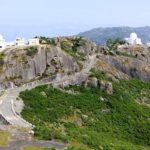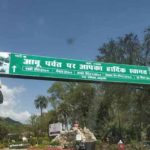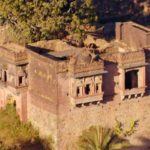Mount Abu Sightseeing a renowned jain pilgrimage destination. It’s never been straightforward to get to paradise, and this one is no exception. Close your eyes and relive the temptations of your destination as you bump along an uneven path, knocking your head against the smooth roof of a deluxe bus. Conjure up the lushness of Mount Abu, which all tourist guides proclaim to be “Rajasthan’s paradise.”
The pamphlet gushes that Mount Abu, Rajasthan’s only hill station, offers you the best of all worlds, with more scenic beauty, more architecture and archaeology in the form of the famous Dilwara caves, the Brahmakumaris’ chief base, and a generous peppering of temples that prove that the place is particularly favoured by the gods. Mount Abu Sightseeing has been an important place of penance for the sages.
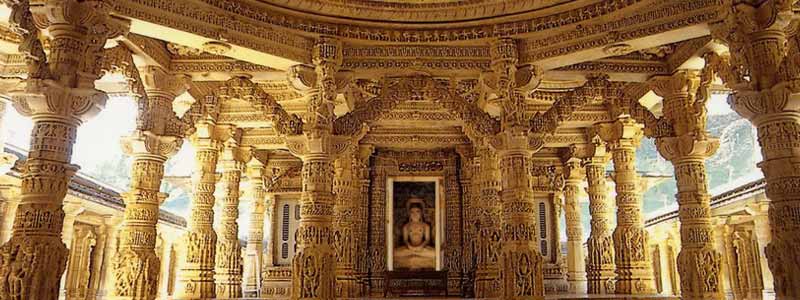
Dilwara Temples
The Dilwara Temple, also known as the Delvada Temple, is the Jains’ most sacred pilgrimage site. Mount Abu Sightseeing, Rajasthan’s only hill station, is only two and a half kilometres away. It is located in Rajasthan’s verdant green Aravali hills. The temple complex is hemmed in by a high wall.
Apart from Jains, it is a popular tourist destination for all. From the outside, Dilwara Temple appears austere. You’ll notice intricate patterns and designs carved into the pillars, archways, walls, and roofs once you enter.
The temple was built by Vastupal and Tejpal. Between the 11th and 13th centuries, Vimal Shah founded the temple. These magnificent temples have served as a refuge for Jain pilgrims and saints since the beginning of time. They flock here to offer prayers with devotion.
The temple complex comprises five fascinating temples, i.e., Vimal Vasahi, Luna Vasahi, Pittalhar, Parshavanatha, and Mahavir Swami Temple, revering to Lord Adinath, Lord Rishabhdeo, Lord Neminath, Lord Mahavir Swami, and Lord Parshvanath, respectively.
Of these five temples, Luna Vasahi and Vimal Vasahi are the most popular among pilgrims. Temples stand out for the massive use of marble and intricate carvings on every nook and corner.
The innermost sanctum contains a central hall, Rang Mandap, and Garbhagraha, where idols are seated in these shrines. The Navchowki ceiling is made up of nine richly decorated ceilings. Other notable structures include Hathishala and Kirthi Stumbh. Dilwara Temples are the epitome of simplicity and austerity, both of which are fundamental Jain ideals and values.
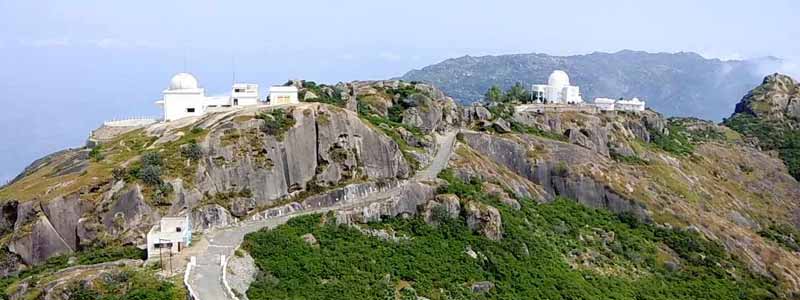
Guru Shikhar
The Guru Shikhar Peak, at a distance of 15 kilometres from Mount Abu, is the highest peak in the Aravalli region. It stands at a height of 1722 metres. This spectacular mountain peak is well-known among hikers. From the top of this mountain peak, visitors can get a bird’s eye view of the entire Aravalli range of mountains.
The Guru Dattatreya Temple, an archaic temple, can be located on the top of this mountain. The temple is dedicated to Guru Dattatreya, believed to be an incarnation of the trinity, Lord Bramha, Lord Vishnu and Lord Shiva.
The Shiva Temple, Mira Temple, and Chamundi Temple are some of the other temples on this peak. Besides temples, the mountain is home to the Mount Abu Sightseeing, a major facility for ground-based infrared observations of celestial objects. The observatory is under the administration of the Physical Research Laboratory (PRL).
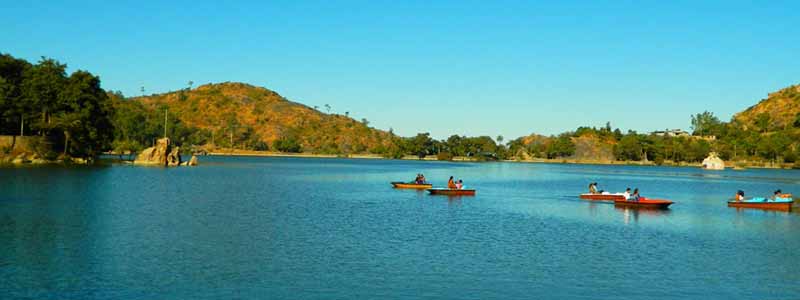
Nakki Lake
Mount Abu’s Nakki Lake, also known as the Nakki Jheel, is a naturalist’s dream. This lake, surrounded by incredible natural wonders, is a true Mount Abu gem. With a depth of about 11,000 metres and a distance of a quarter mile, it is India’s first man-made lake. The fascinating lake, which is located in the heart of the hill station, is surrounded by lush greenery, mountains, and oddly shaped rocks. As you sail through the serene waters of Nakki Lake, it is exciting to see the life of Mount Abu Sightseeing unfolding in front of you. The blowing winds and the soothing temperature of Mount Abu will add to the pleasure of boating and is sure to win your heart.
In the Nakki Lake which is associated with many legends, Mahatma Gandhi’s ashes were immersed on 12 February 1948 and Gandhi Ghat was constructed nearby. It is a perfect destination for nature lovers and photography fiends. On the other hand, the attraction is also considered as the love lake of Mount Abu since the clean blue waters with verdant surroundings give a romantic feel. It is also said to be the sacred lake for the proud Garacia Tribe. The nearby natural wonders that are visible from the lake increases its charm.
There is the famous Toad Rock on a hill. It looks like a toad about to jump in the lake. By the side of the lake, there is a path leading to Sunset Point. Raghunath Temple and Maharaja Jaipur Palace are also located on the hills near the Lake. Finally, a trip to the lake is incomplete without the peaceful boat ride. A perfect getaway to nature’s lap, the Nakki Lake will add some memorable moments to cherish all through.
Shri Raghunath Ji Temple
Sri Raghunathji Temple is dedicated to Raghunathji who is believed to be an incarnation of Lord Vishnu. The pilgrims believe that Lord Raghunath has come upon earth to save the poor souls and help them fight with all tragedies and calamities of life. The temple is believed to liberate one from the pains and pangs of life. The main idol of the temple was believed to be placed by the Great Swami Ramanand, the guru of Sant Kabir.
Constructed in the 14th century AD, this temple holds the rich legacy of the ancient Mewar culture. The temple resembles a palace and has two watch towers on both sides of the entrance. The wonderful idol of the Lord is its prime attraction. The temple walls are nicely decorated with colourful paintings showing the Rajputana heritage. While entering the premise, there is a large structure with two small domes on both sides and a large dome at the middle. The front wall is adorned with life size frescos of Jay, Vijay, Hanuman and Garud. Sri Raghunathji Temple is not only visited by devotees but by tourists as well due to close proximity to the lake.
Adhar Devi Temple
Situated in a cave, The Adhar Devi Temple is one of the popular religious themed tourist destinations in the Mount Abu region. It is situated three kilometers north of the main town of Mount Abu. The Adhar Devi Temple is reached by climbing up 365 stairs carved into the mountain. The temple itself is located inside a rocky cleave and is reached by crawling through a small opening into the cave.
The Adhar Devi Temple is dedicated to the Goddess Durga. It got its name because the legend has it that “Adhar” of the Mataji (Goddess deity) fell here also it was believed that the image of the goddess could be found there hanging in mid air. As well as being a popular tourist destination, the Adhar Devi Temple is also a common destination for many religion pilgrimages The Adhar Devi temple receives most pilgrims during the 9 days of the holy Navratri season.
The Adhar Devi temple contains many beautiful statues, and those that make the effort to climb the stairs are rewarded with many picturesque views of the surrounding mountains and forests. The climb up to the Adhar Devi temple can be a difficult one so it is recommended that you wear appropriate clothing and footwear. You should not be turned off by this walk as the scenic views surrounding the temple and the wondrous beauty inside make this climb worth the effort.
Gaumukh Temple
Gaumukh temple is one of the most popular sacred sites for Hindus in Mount Abu. Climb the height of 700 stairs to arrive at the temple and also adore a panoramic view of the surrounding area. When translated in English, the name of temple means the ‘mouth of the Cow’ as the word ‘Gau’ means cow and ‘Mukh’ means ‘mouth’.
Gaumukh temple is dedicated to Nandi, the divine bull of Lord Shiva (his vehicle) and thus the temple is especially quite popular amidst the followers of Lord Shiva. Water stream falls from the mouth of the bull statue. Devotees and tourists throng the temple in equal numbers, all round the year. The entrance of the temple has a statue of Nandi along with the idols of Lord Krishna, Lord Rama and Rishi Vashishth, placed nearby.
It is believed that the temple exists from the time when Rishi Vashishth lived in Mount Abu. History states that he had performed a Yagna here for seeking the blessings of gods and goddesses for safety of the earth. The site where the Sage had performed Yagna and had offered prayers is called Agni Kund. Gaumukh temple is one of the must-visit places in Mount Abu. As the temple is located amidst thick forest, it is not advisable to visit the temple during monsoon and night hours.
Best Time to Visit
In winter, tourism is at a peak in Rajasthan. To get the experience of Mount Abu, November to June is the best time. Mount Abu has a fine climate for almost the whole year and is one of the amazing places to visit in Mount Abu. To get the best experience, youcan enjoy all the sightseeing and outdoor activities in the winter. Many of the adventure lovers and honeymooners visit the destination in December. You should select the perfect time to enjoy all the activities and places to your fullest.
How to Reach?
By Air: The nearest airport to Mount Abu is Udaipur. You can easily get flights from any major city to Udaipur. You can get a flight on daily basis and you can book them according to your time. From Udaipur, you can take a cab or taxi to Mount Abu.
By Rail: The nearest railway station is Mount Abu railway station. The station is around 10 km far and has a good connection with the major cities of the country. To reach there, cabs and taxies are easily available. You can hire them and reach your destination.
By Road: Most public transportation and private buses operate from nearby Mount Abu towns. There is a regular direct bus service from Udaipur, Jaipur, Ahmedabad, and Baroda to the Hill Station.





